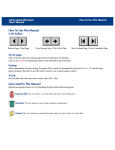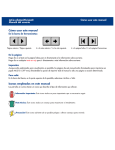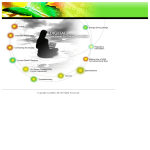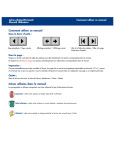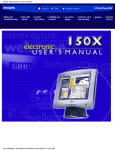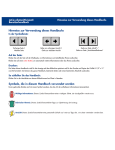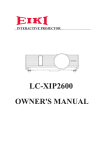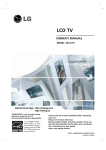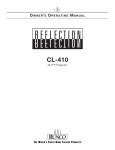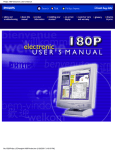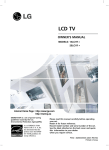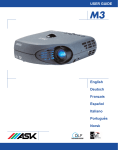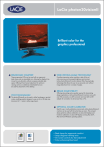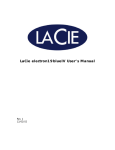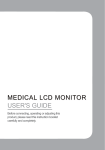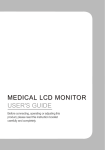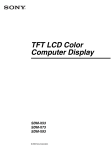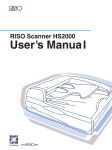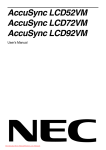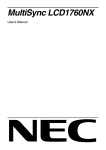Download Lacie Photon 20 Vision II User Guide Manual
Transcript
How To Use This Manual LaCie photon20visionII User’s Manual How To Use This Manual In the toolbar: Previous Page / Next Page Go to Previous View / Go to Next View Go to Contents Page / Go to Precautions Page On the page: Click on the text within the Contents page to jump to information on that topic. Click on any red text to automatically jump to more information about that topic. Printing: While optimized for onscreen viewing, the pages of this manual are formatted for printing on 8 1/2” x 11” and A4 sized paper, giving you the option to print the entire manual or just a specific page or section. To Exit: From the Menu bar at the top of your screen, select: File > Quit. Icons Used In This Manual Italicized paragraphs feature an icon describing the type of information being given. Important Info: This Tech Note: This Caution! This icon refers to an important step that must be followed. icon refers to tips to help maximize performance. icon indicates a potential hazard, and gives tips on how to avoid them. Downloaded from ManualMonitor.com Manuals LaCie photon20visionII User’s Manual Foreword Precautions 1. Introduction 2. Getting to Know Your LaCie photon20visionII Monitor 2.1 Package Contents 2.2 Views of the Monitor 3. Setting Up Your LaCie photon20visionII Monitor 3.1 Connecting Your Monitor 3.2 Location Considerations 3.3 Ergonomic Considerations 3.4 Positioning Your Display 3.4.1 Height Range 3.4.2 Tilt Range 3.4.3 Landscape and Portrait 3.5 Using the USB Ports 3.6 Installing the LaCie Blue Hood 3.7 Cleaning Your Monitor 4. How to Use Your LaCie photon20visionII Monitor 4.1 Control Panel 4.2 On Screen Display (OSD) Control Adjustments 4.3 Recommended Resolution 5. Specifications 5.1 Preset Modes (Resolution) 5.2 Signal Connector Pin Assignments 5.2.1 DVI-I Connector 5.2.2 15-Pin D-SUB Connector 5.3 VESA Mounting and Security Slot 6. Troubleshooting 7. Contacting Customer Service 8. Warranty 9. Appendix 1 –TCO’ 95 10. Appendix 2 – TCO’ 99 Glossary Downloaded from ManualMonitor.com Manuals Table of Contents page 2 3 5 6 7 7 8 11 11 14 14 15 15 16 16 17 18 19 20 20 23 27 28 29 30 30 30 31 32 35 37 38 41 43 LaCie photon20visionII User’s Manual Foreword page 3 Copyrights Copyright © 2004 LaCie. All rights reserved. No part of this publication may be reproduced, stored in a retrieval system, or transmitted in any form or by any means, electronic, mechanical, photocopying, recording or otherwise, without the prior written consent of LaCie. Trademarks Apple, Mac and Macintosh are registered trademarks of Apple Computer, Inc. Microsoft, Windows 98, Windows 98 SE, Windows 2000, Windows Millennium Edition and Windows XP are registered trademarks of Microsoft Corporation. ENERGY STAR is a U.S. registered mark. Other trademarks mentioned in this manual are the property of their respective owners. Changes The material in this document is for information only and subject to change without notice. While reasonable efforts have been made in the preparation of this document to assure its accuracy, LaCie assumes no liability resulting from errors or omissions in this document, or from the use of the information contained herein. LaCie reserves the right to make changes or revisions in the product design or the product manual without reservation and without obligation to notify any person of such revisions and changes. FCC Compliance Statement LaCie photon20visionII This equipment has been tested and found to comply within the limits of a Class B digital device pursuant to Part 15 of the FCC Rules. These limits are designed to Tested To Comply provide reasonable protection against harmful interference in a residential With FCC standards installation. This equipment generates, uses, and can radiate radio frequency energy and if not FOR HOME OR OFFICE USE installed and used in accordance with the instructions, may cause harmful interference to radio communications. However, there is no guarantee that interference will not occur in a particular installation. If this equipment does cause harmful interference to radio or television reception (which can be determined by turning the equipment on and off), the user is encouraged to try to correct the interference by using one or more of the following measures: • Reorient or relocate the receiving antenna. • Increase the separation between the equipment and the receiver. • Connect the equipment into an outlet on a circuit different from that to which the receißver is connected. • Consult the dealer or an experienced radio/TV technician for help. Downloaded from ManualMonitor.com Manuals LaCie photon20visionII User’s Manual Foreword page 4 Caution! Changes or modifications not expressly approved by the party responsible for compliance could void the user's (or your) authority to operate the equipment. Only peripherals (digital input/output devices, terminals, printers, etc.) certified to comply with the Class B limits may be attached to this monitor. Operation with noncertified peripherals is likely to result in interference to radio and TV reception. Only shielded signal cables may be used with this System. NOTICE - The regulations are applied only to the products with the ID LABEL indicating specific requirements. Canadian DOC Notice This Class B digital apparatus meets all requirements of the Canadian Interference-Causing Equipment Regulations. Cet appareil numerique de la classe B respecte toutes les exigences du Reglement sur le materiel brouilleur du Canada. NOTICE - The regulations are applied only to the products with the ID LABEL indicating specific requirements. CE Conformity Notice (for Europe) Products with the “CE” Marking comply with the EMC Directive(89/336/EEC) and LOW VOLTAGE Directive (73/23/EEC) issued by the Commission of the European Community. Compiance with these directives implies conformity to the following European Norms: • EN 55022 ; Radio Frequency Interference • EN 50082-1:1992 ; Electromagnetic Immunity • EN 60555-2 ; Power Line Harmonics • EN 60555-3 ; Voltage Fluctuations • EN 60950 ; Product Safety NOTICE - The regulations are applied only to the products with the ID LABEL indicating specific requirements. Low Radiation Compliance (MPR II) This monitor meets one of the strictest guidelines available today for low radiation emissions, offering the user extra shielding and an antistatic screen coating. These guidelines, set forth by a government agency in Sweden, limit the amount of emission allowed in the Extremely Low Frequency (ELF) and Very Low Frequency (VLF) electromagnetic range. Downloaded from ManualMonitor.com Manuals LaCie photon20visionII User’s Manual Precautions page 5 General Use Precautions Only qualified persons are authorized to carry out maintenance on this device. • Read this User's Guide carefully, and follow the correct procedure when setting up the monitor. • Do not attempt to disassemble or modify your monitor. Never insert any metallic object into the circuitry to avoid any risk of electrical shock, fire, short-circuiting or dangerous emissions. Your monitor contains no user-serviceable parts. If it appears to be malfunctioning, have it inspected by a qualified LaCie Technical Support representative. • Never expose your monitor to rain, or use it near water, or in damp or wet conditions. Never place objects containing liquids on the monitor, as they may spill onto its circuitry. Doing so increases the risk of electrical shock, short-circuiting, fire or personal injury. • Make sure that the computer and the monitor are electrically grounded. If the devices are not grounded, there is an increased risk of electrical shock. • Do not expose the monitor to temperatures outside the range of 5° C to 45° C (41° F to 104° F). Doing so may damage the monitor or disfigure its casing. Avoid placing your monitor near a source of heat or exposing it to sunlight (even through a window). Inversely, placing your monitor in an environment that is too cold or humid may damage the unit. Downloaded from ManualMonitor.com Manuals 1. Introduction LaCie photon20visionII User’s Manual page 6 1. Introduction Congratulations on the purchase of your new LaCie photon20visionII monitor. This professional quality monitor was designed to provide you with a high-resolution monitor that will give you years of reliable, trouble-free operation. LaCie photon20visionII monitors feature: • Wide viewing angle technology • Perfect fit for any size workarea • On-screen controls for quick adjustment Ideally suited for creative professionals using advanced applications like computer-aided graphics, imaging and desktop publishing, LaCie photonvision monitors deliver precise, crisp colors for outstanding results. Featuring state-of-the-art color accuracy and impressive resolutions, these monitors incorporate a brilliant active matrix TFT display to give you the sharpest details and exact viewing control. LIGHT VIEW AUTO SOURCE MENU SELECT These cross-platform monitors are compatible with VGA, DVI and ADC connectors, and feature a USB hub so you can easily and conveniently connect peripheral devices through the monitor. Also available from LaCie is an ergonomic desk clamp that helps to save desktop real-estate and allows the monitor to be positioned in a nearly limitless number of viewing positions and angles. This manual will help you to: • Install your new device properly • Get your monitor up and running • Quickly learn how to operate it Downloaded from ManualMonitor.com Manuals 2. Your LaCie photon20visionII Monitor LaCie photon20visionII User’s Manual page 7 2. Your LaCie photon20visionII Monitor 2.1 Package Contents Your LaCie photon20vision monitor is shipped with the following: LaCie photon20visionII monitor and desktop foot LIGHT VIEW AUTO SOURCE MENU SELECT Power cord VGA to VGA cable DVI to DVI cable ADC to DVI cable USB cable LaCie Blue Hood Pivot Pro CD-ROM for Windows 98SE, Me, 2000 and XP LaCie photonvision v.1.x • LaCie manual • LaCie color profile photon20visionII ©C op y righ t 20 Downloaded from ManualMonitor.com Manuals Included on this CD: MyDVD, Roxio Easy CD Creator, Direct CD, InterVideo, USB 2.0 Driver, 72 DVD-RAM Driver 71 70 30 3 0 31 04, La C ie Ltd. A ll r igh ts r eser ved. LaCie Color Utilities CD-ROM 2. Your LaCie photon20visionII Monitor LaCie photon20visionII User’s Manual page 8 2.2 Views of The Monitor Front view – LIGHT VIEW LIGHT VIEW AUTO SOURCE MENU AUTO SOURCE MENU SELECT SELECT Control Panel – Use the Control Panel to access the On Screen Display (OSD) controls. For more information, see section 4. How to Use Your LaCie photon20visionII Monitor. Downloaded from ManualMonitor.com Manuals LaCie photon20visionII User’s Manual 2. Your LaCie photon20visionII Monitor page 9 Side view – Vacation Switch – Turn on the Vacation Switch after connecting the power supply. For more information, see section 3.1 Connecting Your Monitor. Downloaded from ManualMonitor.com Manuals 2. Your LaCie photon20visionII Monitor LaCie photon20visionII User’s Manual page 10 Rear view – 2 D 3 1 1 Security Slot – Use this slot to connect security cables, such as the LaCie Security Lock. For more information about this function, see section 5.3 VESA Mounting and Security Slot. Power Supply Connector – Use this to connect the Power Supply cable from the monitor to a power outlet. For more information, see section 3.1 Connecting Your Monitor. 2 Signal Cable Connectors – Use these ports to connect either the DVI or VGA signal cables. For more information on these connections, see sections 3.1 Connecting Your Monitor and 5.2 Signal Connector Pin Assignments. 3 4 4 PUSH USB Ports – Use these ports to connect USB peripherals. For more information about this function, see section 3.5 Using the USB Ports. Downloaded from ManualMonitor.com Manuals LaCie photon20visionII User’s Manual 3. Setting Up Your LaCie photon20visionII Monitor page 11 3. Setting Up Your LaCie photon20visionII Monitor 3.1 Connecting Your Monitor 1) Turn off the power to your computer. 2) If you do not already have a graphics card installed, you will need to have one installed prior to installation. Please refer to your graphics card installation manual for more information. 3) Place the monitor in a convenient, well-ventilated location near your computer (for more information about where to place your monitor, see 3.2 Location Considerations). 4) On the back of the stand, press the PUSH button and pull the stand cover down to separate it from the stand. PUSH Downloaded from ManualMonitor.com Manuals PUSH LaCie photon20visionII User’s Manual 3. Setting Up Your LaCie photon20visionII Monitor page 12 5) Connect the signal cable to the back of the monitor. Once the signal cable is attached, tighten the thumbscrews to secure the connection. 6) Attach the female end of the supplied power cable into the AC power connector on the back of the monitor, and the male end into a properly-grounded, three-prong AC outlet. PUSH 7) After connecting the power supply and signal cables, re-attach the stand cover by placing the slots on the bottom back into the holes on the stand. Once securely connected, you should hear a “click” sound when it latches. PUSH Downloaded from ManualMonitor.com Manuals 3. Setting Up Your LaCie photon20visionII Monitor LaCie photon20visionII User’s Manual page 13 8) Connect the signal cable to the monitor connection on the back of your computer and tighten the screws to secure the connection. Computer models vary. Please consult your computer’s User’s Manual for the exact location of your monitor connection. Important Info: Mac Users: your Mac. Some Macs may require the use of the ADC to DVI adapter to connect the monitor to 9) Power on your computer and then the monitor. Important Info: Make sure that the vacation switch, located on the right side of the monitor, is turned on. Downloaded from ManualMonitor.com Manuals LaCie photon20visionII User’s Manual 3. Setting Up Your LaCie photon20visionII Monitor page 14 3.2 Location Considerations Important Info: Correct placement and adjustment of the monitor can reduce eye, shoulder and neck fatigue. When setting up your monitor, keep the following in mind: • For optimal viewing, avoid placing the monitor against a bright background or where sunlight or other light sources may reflect on the display area of the monitor; place your monitor no closer than 12 inches and no further away than 28 inches from your eyes. The optimal distance is 24 inches. • Position the monitor at a 90° angle to windows and other light sources to minimize glare and reflections. Adjust the monitor tilt so that ceiling lights do not reflect on your screen. • Rest your eyes periodically by focusing on an object at least 20 feet away, and blink often. • Adjust the monitor height so that the top of the screen is at or slightly below eye level. Your eyes should look slightly downward when viewing the middle of the screen. • Place the monitor away from strong magnetic or electromagnetic fields, such as high-capacity transformers, electric motors, large-current power lines and steel pillars. Magnetism can cause distortion in the picture and/or color purity. • Avoid covering the slots or openings of the monitor. Allow adequate ventilation around the monitor so the heat from the monitor can properly dissipate. Avoid putting the monitor into any enclosure that does not have adequate ventilation. • Avoid exposing the monitor to rain, excessive moisture or dust, because this can cause a fire or shock hazard. • Avoid placing the monitor, or any other heavy object, on the power cord. Damage to the power cord can cause a fire or electrical shock. • Handle the monitor with extreme care when transporting. 3.3 Ergonomic Considerations To realize the maximum ergonomic benefits, we recommend the following: • Adjust the brightness until the background raster disappears • Do not position the Contrast control to its maximum setting • Use the preset Size and Position controls with standard signals • Use the preset Color Setting and Sides Left/Right controls • Use non-interlaced signals with a vertical refresh rate between 75-160Hz • Do not use primary color blue on a dark background, as it is difficult to see and may produce eye fatigue due to insufficient contrast Downloaded from ManualMonitor.com Manuals LaCie photon20visionII User’s Manual 3. Setting Up Your LaCie photon20visionII Monitor page 15 3.4 Positioning Your Display Adjust the position of the panel for maximum comfort. 3.4.1 Height Range Before adjusting your monitor’s height, follow these steps: 1) Before pushing the lock, push the monitor down. Now push the lock to the left. PUSH 2) Hold the base of the monitor, and with your other hand gently pull the monitor up to adjust the height. Push the lock back to the right once you have adjusted the monitor to its appropriate height. PUSH Downloaded from ManualMonitor.com Manuals Height Range: Maximum height = 3.15 in (80.0 mm) 80.0mm 3. Setting Up Your LaCie photon20visionII Monitor LaCie photon20visionII User’s Manual page 16 3.4.2 Tilt Range Tilt Range = -5° to 30° 5˚ 0˚ 30˚ 3.4.3 Landscape And Portrait You can rotate the panel 90°, clockwise. For more detailed information on this feature, please refer to the Pivot Pro Software CD-ROM, included with your monitor. Important Info: The rotational capabilities offered by Pivot Pro are supported under Windows 98SE, Me, 2000 and XP. At the time of publication (April, 2004), Mac OS X does not support the rotational capabilities offered by Pivot Pro. Downloaded from ManualMonitor.com Manuals 3. Setting Up Your LaCie photon20visionII Monitor LaCie photon20visionII User’s Manual page 17 3.5 Using the USB Ports The Universal Serial Bus (USB) ports allow you to connect different desktop peripherals to your computer. By using the USB ports on your LaCie photon20visionII monitor, you can connect your mouse, keyboard or other USB compliant devices to your monitor, instead of connecting them to your computer or a hub. The LaCie photon20visionII has an integrated, self-powered USB hub that allows you to connect up to two other USB devices. USB Connection 1) Connect one end of a USB cable to the upstream port of your display, and the other end of the USB cable to a compliant port on your computer or USB hub. 2) Connect USB compliant peripheral devices to your monitor using the monitor’s downstream ports. PUSH Upstream port, To computer Important Info: Downstream port, To devices • To activate the USB hub of your LaCie photon20vision, the display must be connected to a USB compliant computer or hub with a USB cable. • When connecting the USB cable, ensure that the cable end matches the port that you are attaching it to. • Even if the display is in power save mode, USB compliant devices will still function when they are connected to the display. Downloaded from ManualMonitor.com Manuals LaCie photon20visionII User’s Manual 3. Setting Up Your LaCie photon20visionII Monitor page 18 3.6 Installing the LaCie Blue Hood The LaCie color enhancing hood guarantees the most accurate and consistent colors on the monitor by reducing the interference of surrounding light, and by reducing light reflection and shadows. Installation Before you install the hood, first decide which position, portrait or landscape, that you are going to use the monitor in. Landscape 1) Place the landscape top panel onto the back of the monitor, and insert the three tabs of the top into the three holes on the back of the monitor. 2) Slide the side panels, with the soft velvet side of the tabs facing the monitor, into the grooves on the top panel. Important Info: The rotational capabilities offered by Pivot Pro are supported under Windows 98SE, Me, 2000 and XP. At the time of publication (April, 2004), Mac OS X does not support the rotational capabilities offered by Pivot Pro. Portrait Repeat the same installation process for portrait mode as in landscape, except that there are no tabs on the top panel. Downloaded from ManualMonitor.com Manuals LaCie photon20visionII User’s Manual 3. Setting Up Your LaCie photon20visionII Monitor page 19 3.7 Cleaning Your Monitor A special coating has been applied to the glass of your monitor to reduce reflection and static electricity on the glass surface. Due to this delicate coating on the glass surface, use a lint-free, nonabrasive cloth (cotton or equivalent) and a non-alcohol, neutral, nonabrasive cleaning solution to minimize dust. If the screen requires more than a light cleaning, apply water or a soft, neutral detergent, diluted with ample water, directly to a soft cloth. Wring out the excess water, then clean the glass surface. Caution! Always unplug the monitor before cleaning. Caution! The following agents will cause damage to the monitor when cleaning the glass surface: Benzene, thinner, acid/alkaline detergent, alcohol detergent, detergent with abrasive powder, detergent with antistatic agent and detergent for cleaning. Caution! circuitry. Do not spray cleaner directly onto the screen, because it may drip into the monitor and damage the Downloaded from ManualMonitor.com Manuals 4. How To Use Your LaCie photon20visionII Monitor LaCie photon20visionII User’s Manual page 20 4. How To Use Your LaCie photon20visionII Monitor 4.1 Control Panel LIGHT VIEW LIGHT VIEW AUTO SOURCE MENU 5 6 7 2 Downloaded from ManualMonitor.com Manuals AUTO SOURCE MENU SELECT SELECT 3 4 1 LaCie photon20visionII User’s Manual 4. How To Use Your LaCie photon20visionII Monitor page 21 1 – Power Button / Power (DPMS) Indicator Use this button to turn the display on or off; this indicator lights up green when the display operates normally. If the display is in DPM (energy saving) mode, this indicator changes colors to amber. 2 – Menu Button Use this button to enter or exit the OSD (On Screen Display). 3 – Arrow Buttons / Direct Access Function Use these buttons to choose or adjust items in the OSD. Brings up the Contrast and Brightness adjustments. 4 – Select Button Use this button to enter a selection in the OSD. 5 – Light View This function optimizes the brightness, contrast or color value to the surrounding conditions and settings, and enables you to enjoy the most suitable picture by adjusting the surroundings (DAY/NIGHT/USER MODE). • TEXT: for viewing letters • MOVIE: for viewing movies • PHOTO: for viewing pictures or the photographs • USER MODE: this function memorizes the manual adjustment – Brightness, Contrast and Color values on the OSD. 6 – AUTO Adjustment Function When adjusting your display settings, always press the AUTO button before entering the OSD. This will automatically adjust your display image to the ideal settings for the current screen resolution size (display mode). The best display mode is 1600 x 1200 @ 60Hz. Downloaded from ManualMonitor.com Manuals LaCie photon20visionII User’s Manual 4. How To Use Your LaCie photon20visionII Monitor page 22 7 – SOURCE Selection: SOURCE SELECT Use this button to make the DVI digital, DVI analog or D-SUB analog connector active. This feature is used when two computers are connected to the display. The default setting is D-SUB. • DVI digital • DVI analog • D-SUB analog Locking/Unlocking Controls: MENU and This function allows you to secure the current control settings so that they cannot be inadvertently changed. Press and hold the MENU button and the button for 3 seconds – the “CONTROLS LOCKED” message appears. You can unlock the OSD controls at any time by pushing the MENU button and the button for 3 seconds – the “CONTROLS UNLOCKED” message appears. Downloaded from ManualMonitor.com Manuals 4. How To Use Your LaCie photon20visionII Monitor LaCie photon20visionII User’s Manual page 23 4.2 On Screen Display (OSD) Control Adjustments Screen Adjustment Making adjustments to the image size, position and operating parameters of the display is quick and easy with the OSD control system. The following section is an outline of the available adjustments and selections you can make using the OSD. Important Info: Allow the display to stabilize for at least 30 minutes before making image adjustments. To make adjustments in the OSD, follow these steps: 1) Press the MENU button, then the main OSD menu appears. 2) To access a control, use the 3) Use the or buttons. When an icon you want becomes highlighted, press the SELECT button. buttons to adjust the item to the desired level. 4) Accept the changes by pressing the SELECT button. 5) Exit the OSD by pressing the MENU button. Downloaded from ManualMonitor.com Manuals 4. How To Use Your LaCie photon20visionII Monitor LaCie photon20visionII User’s Manual page 24 OSD Selection and Adjustment The following table indicates all the OSD control, adjustment and setting menus. Main Menu Contrast/Brightness Color Adjustment Image Position Tracking Setup OSD Position Sub Menu Contrast Brightness User (R/G/B) 9300K 6500K H Position V Position Auto Clock Phase Language Image Size Transparency Zoom Horizontal Vertical A X X X X X X X X X X X X X X X X D Reference Adjust the brightness and contrast of the screen X Customize the color of the screen Adjust the position of the screen Improve the clarity and stability of the screen X X X X X X Customize the screen status for the operating environment Adjust the position of the OSD window on the screen X = Adjustable; A = Analog Input; D = Digital Input Contrast/Brightness Contrast Adjusts the contrast of the screen. Brightness Adjusts the brightness of the screen. Downloaded from ManualMonitor.com Manuals LaCie photon20visionII User’s Manual 4. How To Use Your LaCie photon20visionII Monitor page 25 Color Adjustment User (R/G/B) Set your own color levels 9300K: Select the screen color (slightly bluish/white) 6500K: Select the screen color (slightly reddish/white) Image Position Vertical Position Moves the image up or down Horizontal Position Moves image left or right Downloaded from ManualMonitor.com Manuals LaCie photon20visionII User’s Manual 4. How To Use Your LaCie photon20visionII Monitor page 26 Tracking Auto This function is suitable for analog signal input only. This button automatically adjusts the screen position, clock and phase. Clock Minimizes any vertical bars or stripes visible on the screen background. The horizontal screen size also changes. Phase Adjusts the focus of the display. This allows you to remove any horizontal noise, and clears and sharpens the image of characters. Phase adjustment should be performed after adjusting the Clock. Setup Language Choose the language in which the control names will be displayed. Image Size This function displays the image in its original size, or enlarged size, so that it will fit in the full screen of the LCD panel. Transparency Adjusts the transparency of the OSD menu screen. Zoom Adjust the horizontal and vertical image size simultaneously. If you want to move the zooming point, use the H/V Position function in the sub-menu. If the monitor is turned off while zooming in and out of the screen, the monitor will return to the original screen. Downloaded from ManualMonitor.com Manuals LaCie photon20visionII User’s Manual 4. How To Use Your LaCie photon20visionII Monitor page 27 OSD Position Horizontal Position Adjusts the horizontal position of the OSD window on the screen. Vertical Position Adjusts the vertical position of the OSD window on the screen. 4.3 Recommended Resolution For optimal viewing quality, it is recommended that you set the resolution of your photon20vision monitor to 1600 x 1200. This allows the image on the screen to be fully displayed, and you will also achieve maximum sharpness. Downloaded from ManualMonitor.com Manuals 5. Specifications LaCie photon20visionII User’s Manual 5. Specifications Display Sync Input Video Input Resolution 20.1 inches (51.0cm) Flat Panel Active matrix – TFT LCD Anti-glare coating 20.1 inches viewable 0.255mm pixel pitch Horizontal Freq. Analog 28 – 92kHz (automatic) Digital 30 – 80kHz (automatic) Vertical Freq. 56 – 85Hz (automatic) Input Form Separate TTL, Positive/Negative Composite TTL, Positive/Negative SOG (Sync On Green) Digital Signal Input 15 pin D-SUB Connector DVI-I Connector (Digital/Analog) Input Form RGB Analog (0.7Vp-p/75ohm), Digital Max D-SUB: Analog – VESA 1600x1200 @ 60Hz DVI: Analog – VESA 1600x1200 @ 60Hz Digital – VESA 1600x1200 @ 60Hz VESA 1280x1024 @ 70Hz Luminance Contrast Ratio Response Time Plug & Play Display Color Signal Cable Maximum Pixel Clock Dimensions & Weight (with tilt/swivel stand) Tilt/Swivel Range Power Input Environmental Conditions Power Cord 200 cd/m2 (Typical) 400:1 (Typical) 16ms DDC 2B 16.7 M Color (True) 15pin-to15pin D-SUB Cable, DVI-D Cable (Detachable) Analog: 205MHz Digital: 135MHz Width: 17.56 in / 44.60cm Height: 17.54 in / 44.56cm (Min.) 20.69 in / 52.56cm (Max.) Depth: 9.34 in / 23.73cm Net: 22.18 lbs / 10.06kg Tilt range: -5° – 30° Swivel range: 90° Height range: 3.15 in / 80mm Rotate range: 90° clockwise (landscape > portrait) AC 100-240V / 60Hz 1.2A Operating Conditions Temperature – 10°C to 35°C Humidity – 10% to 80% non-condensing Storage Conditions Temperature – -20°C to 60°C Humidity – 5% to 95% non-condensing Wall-outlet type or PC-outlet type Downloaded from ManualMonitor.com Manuals page 28 Information in this section is subject to change without notice. Important Info: 5. Specifications LaCie photon20visionII User’s Manual page 29 5.1 Preset Modes (Resolution) 1 2 3 4 5 6 7 8 9 10 11 12 13 14 15 16 17 18 Display Modes (Resolution) 640 x 350 640 x 480 640 x 480 640 x 480 720 x 400 800 x 600 800 x 600 800 x 600 832 x 624 1024 x 768 1024 x 768 1024 x 768 1152 x 870 1152 x 900 1280 x 1024 1280 x 1024 1600 x 1024 1600 x 1200 Horizontal Freq. (kHz) 31.47 31.47 37.50 43.27 31.47 37.88 46.88 53.67 49.72 48.36 60.02 68.68 68.68 61.80 63.98 79.98 62.11 75.00 Downloaded from ManualMonitor.com Manuals Vertical Freq. (Hz) 70 60 75 85 70 60 75 85 75 60 75 85 75 65.96 60.02 75.02 60 60 5. Specifications LaCie photon20visionII User’s Manual page 30 5.2 Signal Connector Pin Assignments 5.2.1 DVI-I Connector 5.2.2 15-pin D-SUB (VGA) Connector 1 8 9 16 17 24 C1 C2 C3 Downloaded from ManualMonitor.com Manuals 10 11 C4 Pin Signal (DVI-I) 1 T.M.D.S. Data22 T.M.D.S. Data2+ 3 T.M.D.S. Data2/4 Shield 4 T.M.D.S. Data45 T.M.D.S. Data4+ 6 DDC Clock 7 DDC Data 8 Analog Vertical Sync. 9 T.M.D.S. Data110 T.M.D.S. Data1+ 11 T.M.D.S. Data1/3 Shield 12 T.M.D.S. Data313 T.M.D.S. Data3+ 14 +5V Power 15 Ground (return for +5V, H. Sync. and V. Sync.) 16 Hot Plug Detect 17 T.M.D.S. Data018 T.M.D.S. Data0+ 19 T.M.D.S. Data0/5 Shield 20 T.M.D.S. Data521 T.M.D.S. Data5+ 22 T.M.D.S. Clock Shield 23 T.M.D.S. Clock+ 24 T.M.D.S. ClockC1 Analog Red C2 Analog Green C3 Analog Blue C4 Analog H. Sync. C5 Analog Ground T.M.D.S. (Transition Minimized Differential Signaling) 5 1 6 C5 Pin 1 2 3 4 5 6 7 8 9 10 11 12 13 14 15 15 Signal (15-pin S-SUB) Red Green Blue Ground Self-Test Red Ground Green Ground Blue Ground NC Ground Ground SDA Hori. Sync Vert. Sync SCL 5. Specifications LaCie photon20visionII User’s Manual page 31 5.3 VESA Mounting and Security Slot The LaCie photon20visionII monitor is compliant with the Video Electronics Standards Association (VESA) Flat Display Mounting Interface (FDMI) mounting standards, which define a set of corresponding standards that describe interface mounting pads, wall mount brackets and other mounting apparatus to be provided by mounting equipment manufacturers, such as the LaCie Desk Clamp. The LaCie photon20visionII monitor is also comes with a security solution to provide a physical means of securing your monitor. It is compatible with security locks, such as the LaCie Security Lock. VESA Mounting Interface Lock Slot PUSH Downloaded from ManualMonitor.com Manuals 6. Troubleshooting LaCie photon20visionII User’s Manual page 32 6. Troubleshooting In the event that your LaCie photon20visionII Monitor is not working correctly, please refer to the following checklist to find out where the problem is coming from. If you have gone through all of the points on the checklist and your drive is still not working correctly, please have a look at the FAQs that are regularly published on our Web site – www.lacie.com. One of these FAQs may provide an answer to your specific question. You can also visit the drivers pages, where the most recent software updates will be available. If you need further assistance, please contact LaCie Technical Support (see chapter 7. Contacting Customer Service for details). The Problem Questions to Ask Possible Solutions No Image Appears Is the display’s power cord connected? Check and ensure that the power cord is connected properly to the power outlet. Is the power indicator light on? Press the Power button. Is the power on and the power indicator green? Adjust the brightness and contrast. Is the power indicator amber? If the display is in power save mode, try moving mouse or press any key on the keyboard to bring up the screen. Make sure that the power is on. Check to see that your computer is on. Is there an “OUT OF RANGE” message on the screen? This message appears when the signal from the PC (video card) is out of horizontal or vertical frequency range on the display. Check the Specifications section, and then reconfigure your display. Is there a “CHECK SIGNAL CABLE” This message appears when the signal cable between message on the screen? your computer and your monitor is not connected. Check the signal cable and try again. Downloaded from ManualMonitor.com Manuals 6. Troubleshooting LaCie photon20visionII User’s Manual page 33 The Problem Questions to Ask Possible Solutions The “CONTROLS LOCKED” message appears on the screen. Does the “CONTROLS LOCKED” This function allows you to prevent the current control message appear when you push the settings from inadvertently being changed. To unlock MENU button? the OSD controls, push and hold the MENU button and button for 3 seconds – the “CONTROLS UNLOCKED” message will then appear. The display image is incorrect. Is the display position incorret? Press the AUTO button to automatically adjust your display image to its ideal setting. If you do not get the results you desire, adjust the image position manually using the H position and V position icon in the OSD. Check Control Panel > Display > Settings to see if the frequency or the resolution was changed. If it was, readjust the video card to the recommended resolution. On the screen’s background, are Press the AUTO button to automatically adjust your there vertical bars or stripes visible? display image to its ideal setting. If you do not get the results you desire, adjust the vertical bars or stripes manually using the CLOCK icon in the OSD. Is there horizontal noise appearing in an image, or are characters not being clearly portrayed? Press the AUTO button to automatically adjust your display image to its ideal setting. If you do not get the results you desire, manually adjust the horizontal bars using the PHASE icon in the OSD. Check Control Panel > Display > Settings and adjust your monitor to the recommended resolution, and adjust your display image to the ideal setting. Set the color setting higher than 24 bits (true color). Is the screen color mono or abnormal? Check to see that the signal cable is properly connected, and use a screwdriver to fasten the screws. Make sure that your video card is properly inserted in its slot. Check Control Panel > Display > Settings and set the color setting higher than 24 bits (true color). Downloaded from ManualMonitor.com Manuals 6. Troubleshooting LaCie photon20visionII User’s Manual page 34 The Problem Questions to Ask Possible Solutions The display image is incorrect. Is the screen blinking? Check to see if the screen is set to interlace mode. If it is, change it to the recommended resolution. Make sure that the power voltage is high enough. It has to be higher than AC 100-240V 50/60Hz. The “IMAGE SIZE” function in the OSD menu does not work. Installing the Display Driver. The USB port is not working properly. Check to see if the resolution is set at 1600x1200, or less than 512x360. The optimal resolution is 1600x1200, and the image is fully displayed on the monitor and is not converted as a 1:1 image size. If the resolution is less than 512x360, the image size will be smaller than the OSD, and it will also not be converted as a 1:1 image size. Have you installed the Display Driver? Be sure to install the Display Driver that was included with your monitor. Does the “Unrecognized monitor, Plug&Play(VESA DDC) monitor found” message appear? Check to ensure that your video card supports Plug & Play functionality. See your video card’s documentation for more information. Is the USB cable connected properly? Make sure that both ends of the USB cable are properly attached. Does your computer system support Check to see that your system supports the USB USB functionality? standard. See your computer system’s user’s manual for more information. Downloaded from ManualMonitor.com Manuals LaCie photon20visionII User’s Manual 7. Contacting Customer Support page 35 7. Contacting Customer Support Before You Contact Technical Support 1) Read the manuals and review the Troubleshooting section. 2) Try to isolate the problem. If possible, make the monitor the only external device on the CPU, and make sure all cables are correctly and firmly attached. If you have asked yourself all of the pertinent questions in the troubleshooting checklist, and you still can't get your LaCie monitor to work properly, contact us via the provided Web link. Before contacting us, make sure that you are in front of your computer and that you have the following information on hand: 1) Your monitor's serial number 2) Computer brand and model 3) Operating system and version (Mac OS or Windows) 4) Amount of memory installed 5) Names of CD or DVD drives installed on your computer 6) Names of any other devices installed on your computer Downloaded from ManualMonitor.com Manuals 7. Contacting Customer Support LaCie photon20visionII User’s Manual page 36 LaCie Technical Support LaCie Australia Contact Us At: http://www.lacie.com/au/contact/ LaCie Belgium Contact Us At: http://www.lacie.com/be/contact/ LaCie Canada Contact Us At: http://www.lacie.com/caen/contact/ (English) LaCie Denmark Contact Us At: http://www.lacie.com/dk/contact/ LaCie Finland Contact Us At: http://www.lacie.com/fi/contact LaCie France Contact Us At: http://www.lacie.com/fr/contact/ LaCie Germany Contact Us At: http://www.lacie.com/de/contact/ LaCie Italy Contact Us At: http://www.lacie.com/it/contact/ LaCie Japan Contact Us At: http://www.lacie.co.jp LaCie Netherlands Contact Us At: http://www.lacie.com/nl/contact/ LaCie Norway Contact Us At: http://www.lacie.com/no/contact/ LaCie Spain Contact Us At: http://www.lacie.com/es/support/request LaCie Sweden Contact Us At: http://www.lacie.com/se/contact/ LaCie Switzerland Contact Us At: http://www.lacie.com/chfr/contact LaCie United Kingdom & Ireland Contact Us At: http://www.lacie.com/uk/support/request LaCie USA Contact Us At: http://www.lacie.com/contact/ LaCie Grand Export Contact Us At: http://www.lacie.com/intl/contact/ Downloaded from ManualMonitor.com Manuals LaCie photon20visionII User’s Manual 8. Warranty page 37 8. Warranty LaCie warrants your monitor against any defect in material and workmanship, under normal use, for the period designated on your warranty certificate. In the event this product is found to be defective within the warranty period, LaCie will, at its option, repair or replace the defective monitor. This warranty is void if: • The monitor was operated/stored in abnormal use or maintenance conditions; • The monitor is repaired, modified or altered, unless such repair, modification or alteration is expressly authorized in writing by LaCie; • The monitor was subjected to abuse, neglect, lightning strike, electrical fault, improper packaging or accident; • The monitor was installed improperly; • The serial number of the monitor is defaced or missing; • The tamper seal on the monitor casing is broken. LaCie will not, under any circumstances, be liable for direct, special or consequential damages such as, but not limited to, damage or loss of property or equipment, loss of profits or revenues, cost of replacement goods, or expense or inconvenience caused by service interruptions. Under no circumstances will any person be entitled to any sum greater than the purchase price paid for the drive. To obtain warranty service, call your LaCie Reseller or LaCie Technical Support. You maybe asked to furnish proof of purchase to confirm that the drive is still under warranty. All monitors returned to LaCie must be securely packaged in their original box and shipped with postage prepaid. Register online for free technical support:www.lacie.com/register.htm Downloaded from ManualMonitor.com Manuals LaCie photon20visionII User’s Manual 9. Appendix 1 – TCO’ 95 page 38 9. Appendix 1 – TCO’ 95 Congratulations! You have just purchased a TCO’95 approved and labeled product! Your choice has provided you with a product developed for professional use. Your purchase has also contributed to reducing the burden on the environment and to the further development of environmentally-adapted electronic products. Why do we have environmentally labeled computers? In many countries, environmental labeling has become an established method for encouraging the adaptation of goods and services to the environment. The main problem as far as computers and other electronic equipment are concerned is that environmentally harmful substances are used both in the products and during their manufacture. Since it has not been possible so far for the majority of electronic equipment to be recycled in a satisfactory way, most of these potentially damaging substances sooner or later enter nature. There are also other characteristics of a computer, such as energy consumption levels, that are important from both the working and natural environment viewpoints. Since all types of conventional electricity generation have a negative effect on the environment (acidic- and climatic-influencing emissions, radioactive waste, etc.), it is vital to conserve energy. Electronic equipment in offices consumes as enormous amount of energy, since it is often routinely left running continuously. What does the environmental labeling involve? This product meets the requirements for the TCO’95 scheme, which provides for international environmental labeling of personal computers. The labeling scheme was developed as a joint effort by the TCO (The Swedish Confederation of Professional Employees), Naturckyddsforeningen (The Swedish Society for Nature Conservation), and NUTEK (The National Board for Industrial and Technical Development in Sweden), and SEMKO AB (an international certification agency). The requirements cover a wide range of issues: environment, ergonomics, usability, emission of electrical and magnetic fields, energy consumption and electrical and fire safety. The environmental demands concern, among other things, restriction on the presence and use of heavy metals, brominated and chlorinated flame retardants, CFCs (freons), and chlorinated solvents. The product must be prepared for recycling, and the manufacturer is obliged to have an environmental plan, which must be adhered to in each country where the company implements its operational policy. The energy requirements include a demand that the computer and/or display, after a certain period of inactivity, shall reduce Downloaded from ManualMonitor.com Manuals LaCie photon20visionII User’s Manual 9. Appendix 1 – TCO’ 95 page 39 its power consumption to a lower level, in one or more stages. The length of time to reactivate the computer shall be reasonable for the user. Labeled products must meet strict environmental demands, for example, in respect of the reduction of electric and magnetic fields, along with physical and visual ergonomics and good usability. The following is a brief summary of the environmental requirements met by this product. The complete environmental criteria document may be ordered from: TCO Development Unit Linnegatan 14, S-11494 Stockholm, Sweden FAX +46-8 782 92 07 E-mail (Internet): [email protected] Current information regarding TCO’95 approved and labeled products may also be obtained on the Internet using the address: http://www.tco-info.com/ TCO’95 is a co-operative project between: Environmental requirements Brominated flame retardants are present in printed circuit boards, cabling, casings, and housings, and are added to delay the spread of fire. Up to 30% of the plastic in a computer casing can consist of flame-retardant substances. These are related to another group of environmental toxins, PCBs, and are suspected of giving rise to similar harm, including reproductive damage in fish-eating birds and mammals. Flame retardants have been found in human blood, and researchers fear that they can disturb fetus development. Bio-accumulative* TCO’95 demands require that plastic components weighing more than 25 grams must not contain flame retardants with organically bound chlorine or bromine. Lead can be found in picture tubes, display screens, solder, and capacitors. Lead damages the nervous system and in higher doses causes lead poisoning. The relevant bioaccumulative TCO’95 requirement permits the inclusion of lead, as no replacement has yet been developed. Downloaded from ManualMonitor.com Manuals LaCie photon20visionII User’s Manual 9. Appendix 1 – TCO’ 95 page 40 Cadmium is present in rechargeable batteries and in the color-generating layers of certain computer displays. Cadmium damages the nervous system and is toxic in high doses. The relevant bio-accumulative TCO’95 requirement states that batteries may not contain more than 25 ppm (parts per million) of cadmium. The color-generating layers of display screens must not contain any cadmium. Mercury is sometimes found in batteries, relays and switches. Mercury damages the nervous system and is toxic in high doses. The relevant bio-accumulative TCO’95 requirement states that batteries may not contain more than 25 ppm of mercury and that no mercury is present in any of the electrical or electronic components concerned with the display unit. CFCs (freons) are sometimes used for washing printed circuit boards and in the manufacture of expanded foam for packaging. CFCs break down ozone and thereby damage the ozone layer in the atmosphere, causing increased reception on Earth of ultraviolet light with consequent increased risks of skin cancer (malignant melanoma). The relevant TCO’95 requirement: Neither CFCs nor HCFCs may be used during the manufacture of the product or its packaging. *Bio-accumulative means that the substance accumulates within living organisms. Shipping Package The packaging material can be recycled, or you can save it to return the monitor to a service center for repair or disposal. CFC Compounds in Distribution Packaging Cushioning material used for shipping finished monitors are not manufactured with nor do they contain any CFC compounds. Design for Disassembly/Recycling These monitors have been designed for easy end-of-life disassembly and recycling. Fasteners are generally of the same type for efficient disassembly. Components made of different materials can be easily separated and plastics have been identified using international symbols to aid in recycling. Monitor Disposal If you need to dispose of a monitor, ask a qualified service representative for the proper procedure. Improper disposal could result in personal injury from implosion. Caution! Downloaded from ManualMonitor.com Manuals LaCie photon20visionII User’s Manual 10. Appendix 2 – TCO’ 99 page 41 10. Appendix 2 – TCO’ 99 Congratulations! You have just purchased a TCO’99 approved and labeled product! Your choice has provided you with a product developed for professional use. Your purchase has also contributed to reducing the burden on the environment and also to the further development of environmentally adapted electronics products. Why do we have environmentally labeled computers? In many countries, environmental labeling has become an established method for encouraging the adaptation of goods and services to the environment. The main problem, as far as computers and other electronics equipment are concerned, is that environmentally harmful substances are used both in the products and during their manufacture. Since it is not so far possible to satisfactorily recycle the majority of electronics equipment, most of these potentially damaging substances sooner or later enter nature. There are also other characteristics of a computer, such as energy consumption levels, that are important from the viewpoints of both the work (internal) and natural (external) environments. Since all methods of electricity generation have a negative effect on the environment (e.g. acidic and climate influencing emissions, radioactive waste), it is vital to save energy. Electronics equipment in offices is often left running continuously and thereby consumes a lot of energy. What does labeling involve? This product meets the requirements for the TCO’99 scheme which provides for international and environmental labeling of personal computers. The labeling scheme was developed as a joint effort by the TCO (The Swedish Confederation of Professional Employees), Svenska Naturskyddsforeningen (The Swedish Society for Nature Conservation) and Statens Energimyndighet (The Swedish National Energy Administration). Approval requirements cover a wide range of issues: environment, ergonomics, usability, emission of electric and magnetic fields, energy consumption and electrical and fire safety. The environmental demands impose restrictions on the presence and use of heavy metals, brominated and chlorinated flame retardants, CFCs (freons) and chlorinated solvents, among other things. The product must be prepared for recycling and the Downloaded from ManualMonitor.com Manuals LaCie photon20visionII User’s Manual 10. Appendix 2 – TCO’ 99 page 42 manufacturer is obliged to have an environmental policy which must be adhered to in each country where the company implements its operational policy. The energy requirements include a demand that the computer and/or display, after a certain period of inactivity, shall reduce its power consumption to a lower level in one or more stages. The length of time to reactivate the computer shall be reasonable for the user. Labeled products must meet strict environmental demands, for example, in respect of the reduction of electric and magnetic fields, physical and visual ergonomics and good usability. Below you will find a brief summary of the environmental requirements met by this product. The complete environmental criteria document may be ordered from: TCO Development SE-114 94 Stockholm, Sweden Fax: +46 8 782 92 07 Email (Internet): [email protected] Current information regarding TCO’99 approved and labeled products may also be obtained via the Internet, using the address: http://www.tco-info.com/ Environmental requirements Flame retardants Flame retardants are present in printed circuit boards, cables, wires, casings and housings. Their purpose is to prevent, or at least to delay the spread of fire. Up to 30% of the plastic in a computer casing can consist of flame retardant substances. Most flame retardants contain bromine or chloride, and those flame retardants are chemically related to another group of environmental toxins, PCBs. Both the flame retardants containing bromine or chloride and the PCBs are suspected of giving rise to severe health effects, including reproductive damage in fish-eating birds and mammals, due to the bioaccumulative* processes. Flame retardants have been found in human blood and researchers fear that disturbances in fetus development may occur. The relevant TCO’99 demand requires that plastic components weighing more than 25 grams must not contain flame retardants with organically bound bromine or chlorine. Flame retardants are allowed in the printed circuit boards since no substitutes are available. Cadmium** Cadmium is present in rechargeable batteries and in the color-generating layers of certain computer displays. Cadmium damages the nervous system and is toxic in high doses. The relevant TCO’99 requirement states that batteries, the color Downloaded from ManualMonitor.com Manuals 10. Appendix 2 – TCO’ 99 LaCie photon20visionII User’s Manual page 43 generating layers of display screens and the electrical or electronics components must not contain any cadmium. Mercury** Mercury is sometimes found in batteries, relays and switches. It damages the nervous system and is toxic in high doses. The relevant TCO’99 requirement states that batteries may not contain any mercury. It also demands that mercury is not present in any of the electrical or electronics components associated with the labeled unit. CFCs (freons) The relevant TCO’99 requirement states that neither CFCs nor HCFCs may be used during the manufacture and assembly of the product. CFCs (freons) are sometimes used for washing printed circuit boards. CFCs break down ozone and thereby damage the ozone layer in the stratosphere, causing increased reception on earth of ultraviolet light with e.g. increased risks of skin cancer (malignant melanoma) as a consequence. Lead** Lead can be found in picture tubes, display screens, solders and capacitors. Lead damages the nervous system and in higher doses, causes lead poisoning. The relevant TCO’99 requirement permits the inclusion of lead since no replacement has yet been developed. * Bio-accumulative is defined as substances which accumulate within living organisms ** Lead, Cadmium and Mercury are heavy metals which are Bio-accumulative. EPA (U.S.A only) ENERGYSATR is a set of power-saving guidelines issued by the U.S. Environmental Protection Agency(EPA). Downloaded from ManualMonitor.com Manuals LaCie photon20visionII User’s Manual Glossary page 44 Glossary Bit - Representing a value of 0 or 1, a bit is the smallest unit of memory in a computer. Bit depth - The measurement of the amount of color information in an image for display or print. Higher bit depth translates to more color and more accurate color information in the digital image. BMP - Bitmap images, also called raster images. Bitmap files use a grid of pixels to represent images, with every pixel in an image given a specific location and color value. The number of pixels combined make up the image data. Dependent on resolution, bitmap images are best used to show gradations of color. Bitmap images cannot be enlarged unless you change the resolution first, or the images will blur. Brightness - The balance of light and dark shades in an image. Brightness is distinct from contrast, which measures the range between the darkest and lightest shades in an image. Brightness determines the intensity of shades; contrast determines the number of shades you get. Byte - The smallest amount of computer memory needed to store one character of data. CMYK (Cyan, Magenta, Yellow, Black) - The base colors in the printing process. When printing, you should change the color mode for your images to CMYK to give them a better representation of colors. Color Calibration - The process of ensuring accurate reproduction of color for images. Full color calibration is usually a twostep process: calibrating your input device, such as a scanner; and calibrating your output device, such as a printer or monitor. By calibrating input and output devices correctly, color is accurately captured by your scanner and is reproduced faithfully on your monitor or printer as well. Compression - To compress is to decrease in size. Compressing a file makes it smaller and makes it take up less space on a hard drive or other storage device. Contrast - The relationship between the light and dark areas of an image. Contrast is the range between the darkest and lightest shades in an image, while brightness is the balance of light and dark shades. Contrast determines the number of shades you get; brightness determines the intensity of the shades. An image with low contrast tends to look dull and flat. Dot pitch - The measure of how much space there is between a monitor display's pixels. Smaller is better, and packing pixels closer together is fundamental to achieving higher resolution. Downloaded from ManualMonitor.com Manuals LaCie photon20visionII User’s Manual Glossary page 45 DPI - Dots per inch; the measurement of resolution. DPI equals the number of dots that fit horizontally and vertically into a one-inch measurement. Typically, the higher the dpi, the more detail in an image. DPI varies, depending on the output device. A web-page resolution is almost always 72 dpi; a printer 300-1440 dpi (varying according to the printer). Driver - An integral piece of software that provides a computer the necessary information to communicate with a peripheral device. For example, you must install a specific driver for each device (printer or scanner) attached to your computer. Most peripherals that are sold come with the driver stored in a disc, or the drivers are available by visiting the company's Web site for downloading. Exposure - The amount of light in an image. The exposure of an image can be changed by increasing or reducing available light. Gamma - The contrast affecting the mid-level grays or midtones of an image. Adjusting the gamma of an image allows you to change brightness values of the middle range of gray tones without dramatically altering the shadows and highlights. Gigabyte (GB) - A measurement of storage capacity. One gigabyte equals 1,024 megabytes. Grayscale - An image type that contains more than just black and white, and includes actual shades of gray. In a grayscale image, each pixel has more bits of information encoded in it, allowing more shades to be recorded and shown. 4 bits are needed to reproduce up to 16 levels of gray, and 8 bits can reproduce a photo-realistic 256 shades of gray. Highlights - The lightest portions of an image. Histogram - A graphic representation of how bright and dark pixels are distributed in an image. A histogram skewed heavily to the left indicates a dark image, while a histogram skewed to the right indicates a bright image. Hue - The characteristic of a color that distinguishes it from another color; i.e., what makes a color red or green or blue. Interpolated resolution - Resolution enhanced through software; also known as software-enhanced resolution. Interpolated resolution may capture less detail than optical resolution, but it is useful for certain tasks, such as scanning line art or enlarging small originals. Maximum monitor resolution - The number of individual dots of color, or pixels, contained on a display. Resolution is typically expressed by measuring the number of pixels on the horizontal axis (row) and the number of pixels on the vertical axis (column); e.g., 640x480. Megabyte (MB) - A unit of computer memory capacity equal to 1,048,576 bytes. Downloaded from ManualMonitor.com Manuals LaCie photon20visionII User’s Manual Glossary page 46 Midtones - The parts of an image between the lighter and darker areas, at around 50% gray. Moiré - An undesirable pattern in color printing that results from incorrect screen angles of overprinting halftones. Moires usually result when you scan a halftone or when you scan images taken directly from a magazine (instead of scanning a photographic original or a transparency). Pixel - A picture element, or a single unit of a graphic image used by the computer to represent image information in a digital format. An image file, for instance, is simply a representation of hundreds (or thousands) of pixels arranged closely together in a grid so that they appear to form a picture. Refresh rate - The number of times that the image on the monitor display is drawn each second. If the monitor has a refresh rate of 75 Hz, all the pixels from top to bottom are cycled at 75 times a second. Refresh rates are important because they control flicker, and higher refresh rates are better to eliminate eye strain and headaches that result from low refresh rates and flickering. Resolution – The number of pixels that are contained on a monitor display, referenced by the number of pixels on the vertical and horizontal axes. Reflective media - Media capable of reflecting light; e.g., photographs, magazine prints. RGB (Red, Green, Blue) - A color model in which every color is composed of a varying amount of the colors red, green, and blue. Saturation - The intensity of a color, or the degree of color in a particular hue. For example, the green leaves in a tree will appear "more green" if the color is saturated. Shadows - The darkest areas of an image. Downloaded from ManualMonitor.com Manuals














































